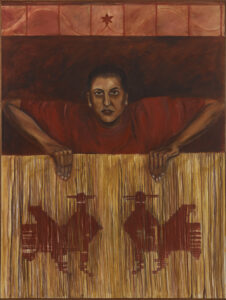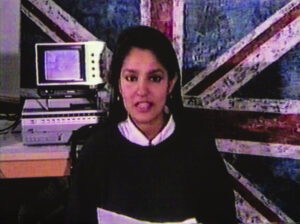Women in Revolt, Art and Activism in the UK, 1970-1990
Nancy Nesvet

reprinted 2023. Courtesy of the artist
In an era in the US where legislation to allow women to control their bodies and their futures has been subverted by the US Supreme Court, where voting rights for blacks are targeted, and where LGBTQ+ people are losing rights afforded to straight people, Women in Revolt, Art and Activism in the UK, 1970-1990 documents the history of second wave feminists who rose up to gain and defend womens’, blacks’ and LGBTQ rights, and begin to recognize transgender rights in the UK. Emphasizing cooperation and collaboration with other women and other groups suffering lack of protection in law, systemic racism, economic dependence on husbands, lack of consent for marital sexual relations, and trans discrimination with sex assigned at birth not changeable, discrimination against the disabled, and lack of recognition of lesbian rights in the public conversation, women banded together to call for human rights and social justice.
This extensive exhibition, including the largest number of art and artifacts ever exhibited in one show at Tate Britain, on view until 7 April 2024, begins with articles from the 1970 National Women’s Liberation Conference, where over twenty thousand activists came together, including members of the Gay Liberation /Front and Brixton Black Women’s Group. Chronologically presenting women artists, working solely and collaboratively to catapult into a movement of diverse practices, personalities, and experiences, both within and outside the museum, the exhibition unfolds. We are first greeted by a flag flying high on a flagpole announcing Here is a Gale Warning by Rose Finn-Kelcey, leading to the exhibition curated by art historians, Rozsika Parker and Griselda Pollack, authors of Framing Feminism, a seminal text on challenges by artists in the UK women’s movement to the male-dominated art world of the nineteen eighties and nineties. The exhibition then visualizes the march from Cardiff to the Royal Air Force Base in Greenham in Berkshire by Women for Life on Earth in September 1981 challenging the setting up of 96 nuclear missile sites there. The Greenham Common Women’s Peace Camp, housing thousands of women including many artists called the anti-nuclear protest a feminist position as money spent for the missiles took funding away from social services, and as mothers, they sought to protect their children from this threat. Together for several years, the group not only made sculptures, artwork, newsletters, and protest lyrics for songs, but also wrapped webs of wool around perimeter fences and formed a human chain of 30,000 people holding hands. This inspiring cooperative action caused women in the UK to act and produce work toward art activism for the next decade in ways documented in this exhibit.
The social and political, the purely artistic and the text and lyrical and musical are all included, showing the extent to which women called attention to the participation they were denied in the arts and in society in general. Emphasizing the relevance of their art to challenges to practices in the art world and the greater society, the exhibition quotes Anne Berg’s and Monica Sjoo’s Images on ‘Womenpower-Arts Manifesto 1971’.

Presented by Tate Patrons 2023 ©:Bhajan Hunjan. Photo by Prudence Cumming
‘WE SAY NO TO EMPTY ABSTRACTIONS, to the ‘art for art’s sake philosophy of the privileged white middle-class male artworld. WE THE OPPRESSED cannot afford this empty play with words and forms, for us the important task is to convey to people, to WOMEN-their dignity and strength and beauty.’
The Curators recognized the need for access to witness the two decade long protest in artistic form outside the museum. Besides the flag flying above the museum entrance, a film documenting Finn-Kelsey’s flags installed at landmarks in the UK and Europe in the 1970s will be shown throughout the exhibition. Bobby Baker’s installation, An Edible Family in a Mobile Home, with walls, ceiling and floors covered with documents and articles proclaiming the quest for Woman power is on show from March 8 through April 7, 2024 as it was until December 3, 2023. Recognizing the ongoing struggle documented in this exhibition, it is this effort to include as many as possible to see the exhibition that makes this a universal cry for women and others represented to continue to revolt against marginalization and lack of inclusion in the arts and society.
Sound, in the form of an ear-splitting cry is first encountered as Gina Birch’s ongoing 3-minute scream, supposedly of a newborn child, played on a loop throughout the exhibition. This screaming, from which new mothers cannot escape, and which only subsides with touch and care for the baby, coincides with the list of domestic chores, documented so well by Mary Kelly, that keeps women engaged before making art or writing. Photography and film is well represented with Post-punk Marianne Elliott-Said and the New-Naturalists verbally attacking the patriarchal structure that keeps them from fulltime artmaking. Feminist printmaking collective ‘See Red Women’s Workshop’ unites art and activism within the print culture produced from 1974-1990. The symbol of the quizzical eyebrow both injected humor into their publication and made clear that all feminists were not angry but could appreciate humor. YBA Wife and Right On Jane also used humor in their posters, as did the billboard portrayed in a photograph declaring ‘If it were a lady, it would get its bottom pinched, and then, scrawled in what was made to appear hand-written commentary, ‘If this lady was a car, she’d run you down’, with the picture of a fiat and the fiat brand label accompanying the text. ‘Untitled’ Linder’s collage (1976) of a nude woman with an iron for a head, mouths for nipples, appearing on a Buzzcocks single, was all I needed to combine humor with outrage.
Craft is often differentiated from art by its identification as useful. Much of the work shown is that designated craft and in fact usually practiced by women, ceramics, embroidery, and textile work blurring the boundaries of craft and art and asking if craft is so assigned to women to intentionally erase its definition as art. Nina Edge’s Snakes and Ladders, an installation of batik on paper and ceramics is a fine example of the genre. So much of this exhibition is text-based, whether posters, magazines, or other literature, asking the question of how much definition and interpretation of artwork into language influences representation of artists and inclusion within the artists’ canon. The articles from the conference first introducing the exhibit, and the Manifesto that closely follows brilliantly emphasizes this point; that adding writing to visual art only explains and documents the aim, as recognized by the Curators, to their credit.
The unification of blacks lacking political power and assuming domestic roles along with white women are well represented in writings and artwork by the BLK Art Group and archive Panchayat which included black and South Asian writings. LGBTQ writings and artworkare represented, specifically attacking Margaret Thatcher’s Section 28, prohibiting the promotion of homosexuality, however that is defined, in the closing chapter of the exhibition. The all-important economic situation of women and its improvement since the 1970’s is not ignored, as Frank Raffle’s and Roshini Kempadoo’s work attests. The AIDS epidemic and lesbian communities are also treated in work by Del La Grace Volcano, Tessa Boffin and Jill Posener. Although lesbians suffered the least amount of AIDS, the communities’ empathy with others in the gay community, adding to the empathy with other communities of the under-represented and politically powerless is openly documented.

The exhibition is far from slick. It is clearly the production of women, not corporate power nor men in high positions, with PR firms producing graphically designed work, reliant on polling and psychological profiling of those they want to reach. The posters and magazines exhibited are raw, the cases and framing unfinished and often absent, emphasizing the urgency of getting the words out, the posters up, echoing Curator Ingrid Pollard’s contention that ‘We weren’t expecting to get exhibitions at the Tate, in the 1980’s, people set up things on their own. We did shows in alternative spaces-community centres, cafes, libraries, our homes. We occupied spaces differently.’ like Dara Birnbaum’s first showing in the front glass window of a beauty Parlor in New York that showed her video, ‘Wonderwoman’ running through a forest of trees, stopped at each tree and forced to go around it. Women came together and cooperated in their cause, including others of marginal representation. It is that golden era of second-wave feminism in the UK that began again, and in the Thatcher era! Of course, they got this exhibition at the Tate. Here is documented artwork, craft, literature, music, performance, notices and posters of conferences and exhibitions, reviews of bands, examples of women-founded record labels, fanzines, punk, and alternative music.
The exhibition is incredibly timely, as women’s, gays and black rights are again being threatened in the US, so we thank the Tate for showing how it was done and unfortunately, must perhaps be done again. The primer is there, instigated by a courageous and creative band of women, to be followed, if necessary, again, and to be recognized as herstory.
